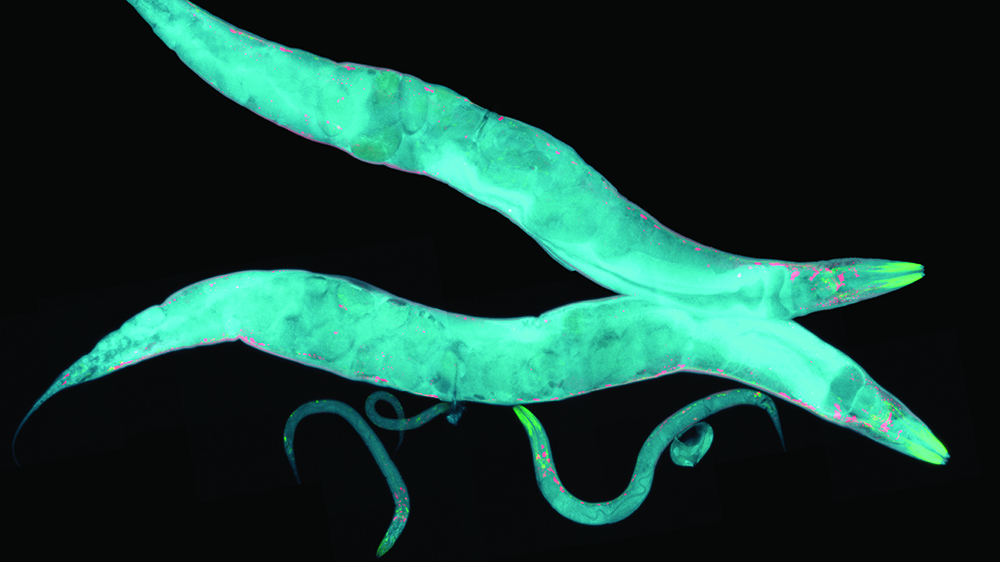MCP: Worms, too, slow down
in old age
In efforts to stave off death, unicellular and multicellular organisms constantly are recycling proteins, breaking down those that are damaged to provide building blocks for fresh copies that can carry out cellular functions. The process is an uphill battle with an inevitable end: The recycling and refreshing slow down, causing cellular damage to continue accruing until the organism dies and ultimately is broken into biochemical materials for other life. This progression, known as senescence, occurs in nearly every organism on Earth and has been studied extensively in the model organism Caenorhabditis elegans.

The roundworms’ decrease in protein turnover doesn’t occur evenly, however. Researchers at Ghent University in Belgium recently determined that two families of proteins involved in intracellular movement and reproduction are especially hard-hit in the worms.
“It’s not a uniform slowdown of the whole set of proteins,” said Ineke Dhondt, a postdoctoral researcher in the university’s Laboratory for Aging Physiology and Molecular Evolution. Dhondt and colleagues at the Pacific Northwestern National Laboratory in Washington recently described their findings in the journal Molecular & Cellular Proteomics. Previous papers in the field had determined that protein turnover in C. elegans decreases with age but hadn’t examined how significantly the effects varied between different families of proteins. “There are proteins that keep or retain their turnover,” Dhondt said. “That might be quite a different insight from other studies that only focus on the bulk protein turnover.”
C. elegans are widely used to study aging due to their short lifespan and well-characterized genomes. To examine which proteins were being turned over, the researchers fed subpopulations of the worms alternating samples of the bacteria Escherichia coli grown with either heavy or light nitrogen isotopes, characterizing the worms’ protein production with mass spectrometry before and after each meal over several days. The difference in isotope weights causes a slight weight difference in proteins that are subsequently synthesized, which can yield information about changes in protein production when compared with the previous spectrometer readings.
Dhondt and her colleagues found that the worms were decreasing their turnover of proteins in the tubulin and vitellogenin families, which are involved in cytoskeletal movement and production of eggs, respectively. They also found that ribosomal proteins, which are responsible for protein synthesis and all generally have a similar half-life, ended up varying widely in their turnover rates.
“We saw that these protein-turnover values really fan out over time,” Dhondt said. “That was an indication that this group might be important to dysregulation of the protein synthesis phenomenon, and that actually can be a key component to underlie aging.”
They also found that proteins responsible for protein degradation, such as the ubiquitin system, tended to continue their turnover throughout aging. “It’s like (the worms) want to keep up their function, so by refreshing these proteins, they want to make sure that these proteins keep functioning,” Dhondt said. “But in the end they’re fighting a battle that they can’t win, because the whole proteome will ultimately collapse.”
Dhondt and colleagues plan to continue studying aging in roundworms, with a new focus on the quality of health the worms exhibit into old age. “An important parameter for us is to look at the ability of the worms to move,” she said. “We are checking not only if the worms are living longer from a certain treatment but whether they are also exhibiting better health.”
Enjoy reading ASBMB Today?
Become a member to receive the print edition monthly and the digital edition weekly.
Learn moreGet the latest from ASBMB Today
Enter your email address, and we’ll send you a weekly email with recent articles, interviews and more.
Latest in Science
Science highlights or most popular articles

What is metabolism
A biochemist explains how different people convert energy differently – and why that matters for your health.

What’s next in the Ozempic era
Diabetes, weight loss and now heart health: A new family of drugs is changing the way scientists are thinking about obesity — and more uses are on the horizon.

How a gene spurs tooth development
University of Iowa researchers find a clue in a rare genetic disorder’s missing chromosome.

New class of antimicrobials discovered in soil bacteria
Scientists have mined Streptomyces for antibiotics for nearly a century, but the newly identified umbrella toxin escaped notice.

New study finds potential targets at chromosome ends for degenerative disease prevention
UC Santa Cruz inventors of nanopore sequencing hail innovative use of their revolutionary genetic-reading technique.

From the journals: JLR
How lipogenesis works in liver steatosis. Removing protein aggregates from stressed cells. Linking plasma lipid profiles to cardiovascular health. Read about recent papers on these topics.

